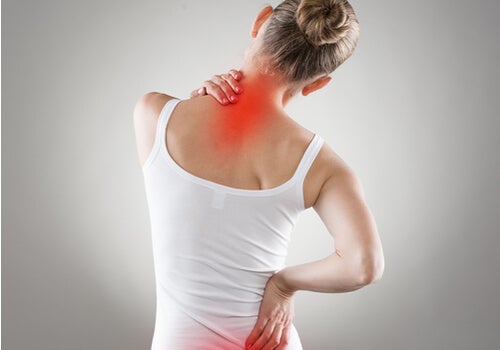Characteristics and Treatment of Neuropathic Pain

Pain is one of the body’s defense mechanisms against harm. However, sometimes, it lingers and becomes a chronic disease in itself. It affects between 19% and 31% of the general population. Estimates indicate that 20% of it is neuropathic pain.
- Neuropathic pain occurs due to an alteration of the structure or function of the peripheral nervous system. It leads to pain even when there’s no external threat, unlike nociceptive pain.
- Nociceptive pain is the unpleasant perception and sensation we experience when faced with a painful stimulus. When we prick ourselves with a needle, for example.
“Numbing the pain for a while will make it worse when you finally feel it.”
-J.K. Rowling-
How does neuropathic pain manifest?
Neuropathic pain manifests differently in each patient. The pain ranges from mild to extremely severe and appears long after a nervous system injury. Unfortunately, it rarely disappears spontaneously.

Everyone experiences pain. However, the sensations can be radically different in people who have the same disease and vice versa. This variety depends on causal, hereditary, and environmental factors. However, neuropathic pain includes both negative and positive symptoms.
The negative symptoms, such as the loss of sensitivity to painful stimuli and temperature, are usually the first indicators. Similarly, the positive symptoms that result from nerve damage can be either spontaneous or evoked.
Among the spontaneous symptoms:
- Paresthesias are abnormal sensations. For example, tingling.
- Dysesthesias are abnormal and unpleasant sensations.
- Shooting, intermittent, or sharp spontaneous pain.
As far as the symptoms evoked are concerned:
- Allodynia is a painful perception of a non-painful stimulus, such as heat or pressure.
- Hyperalgesia is an extremely painful response to a painful stimulus.
- Hyperpathy is a late or explosive response to a painful stimulus.
In addition to these symptoms, people with neuropathic pain often develop sleep disorders and psychological alterations due to it.
The causes
As mentioned above, neuropathic pain is due to an injury of the routes that transmit the information of the pain.
Therefore, the causes are so diverse they’re usually classified into four groups according to their location or anatomical distribution:
- Asymmetric focal or multifocal peripheral nervous system lesions. Among them, post-traumatic, post-operative neuropathies, phantom limb syndrome, post-herpetic neuropathy, HIV, etc.
- Generalized peripheral nervous system lesions. Diabetic, toxic, medicinal, post-infectious, or immunological neuropathy, among others.
- Central nervous system injuries. Cardiovascular accidents, head injuries, multiple sclerosis, tumors, etc.
- Complex neuropathic alterations (without evident injury). Complex regional pain syndromes types I and II.
There’s an inflammatory response in injured tissues when there’s non-chronic pain, causing a temporary sensitization of the area that allows the tissues to heal. However, when the pain and sensitization persist, the receptive neurons begin to act in a non-adaptive manner. Thus, certain stimuli that weren’t painful before will start causing pain or a person will perceive it as more intense.
Treatments for neuropathic pain
A proper diagnosis is essential to find the right treatment. Also, it’s essential to determine if other pathologies are causing pain.
Because neuropathic pain has varied symptoms, you must find an optimal combination adapted to the patient and their pathology. This is because some combinations are more effective than others.
Three groups of treatments
- First-line therapy drugs include antidepressants and neuromodulators, as well as local anesthetics.
- Antidepressants can be either tricyclics (act on noradrenaline), which have been prescribed for more than 25 years for this disease, or dual (act on serotonin and noradrenaline receptors).
- Neuromodulators decrease the release of glutamate, norepinephrine, and substance P. For example, analgesics, anxiolytics, and antiepileptics.
- Local anesthetics in the form of gel or lidocaine patches are also highly recommended. They’re a great option when the pain is localized because they’re a safe and effective method.
- Opioids are among the second-line therapy medications. In fact, they’re quite controversial. However, doctors prescribe them individually or in combination with other drugs in some cases due to their effectiveness.
- Anticonvulsants and antidepressants constitute the third line group, as they’re the least effective.

Non-pharmacological treatments
In addition to these treatments, it’s also advisable to resort to manual therapies, acupuncture, and physiotherapy in some cases. Similarly, psychological therapy can help relieve psychological disorders and improve a person’s quality of life.
However, the most important thing in the treatment of neuropathic pain is to reevaluate it, with the aim of seeing how well it works for the patient. After a patient has tried several ineffective treatments, their doctor must refer them to a pain unit, where professionals can indicate other treatment options.
All cited sources were thoroughly reviewed by our team to ensure their quality, reliability, currency, and validity. The bibliography of this article was considered reliable and of academic or scientific accuracy.
- García, R. C. (2011). Fisiopatología del dolor neuropático. Actualidad Médica, 96(784), 45-59.
- Guevara López, U. (2011). El anestesiólogo y el dolor neuropático. En Carrillo Esper, R., y Covarrubias Gómez, A. Actualidades en dolor (103-117). México D.F: Editorial Alfil.
- Velasco, M. (2014). Dolor neuropático. Revista Médica Clínica Las Condes, 25(4), 600-717.
- Pérez I, Ayuga F. Dolor Neuropático. Boletín Farmacoterapéutico del SESCAM 2008; IX (4):5-8.
This text is provided for informational purposes only and does not replace consultation with a professional. If in doubt, consult your specialist.








